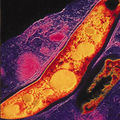Zootopia Syndrome
NSFW! This article may not be safe for work! Unless you work from home ... Either way, this warning came too late to be useful – just mark it as spam and blame the IT guys. |

“UWUWUWUUWU I wanna fuck Judy”
– Patient in a terminal stage of Zootopia Syndrome
Zootopia Syndrome is a disease in which a Furry (A member of the furry fandom, also called fur-fans, or furs) starts to enjoy Zootopia so much that they identify with animals from Zootopia, most often Nick Wilde, but sometimes others. The disease has two forms, the Wild(e) form, and the secluded form.
Symptoms[edit | edit source]
The disease has many symptoms, with the wild(e) form presenting with fursuiting, and the secluded form presenting with drawing large amounts of Nick Wilde/Judy Hopps porn, depending on their sexuality. (Nick Wilde is usually gay, and Judy Hopps is usually bisexual, as no straight people have ever been diagnosed with the syndrome.)
Stages and symptoms[edit | edit source]
Universal[edit | edit source]
Stage -1[edit | edit source]
This stage is before you are aware that Zootopia even exists. It is mostly present in young children, old people, people in 2014 or prior, and people who are forgetting that the world is dying.
Stage 0[edit | edit source]
Stage 0 is an awareness that Zootopia exists, and may present with attraction, disgust, or not caring, which is most likely. The effects in this stage are inconclusive, and usually are meaningless.
Wild(e) form[edit | edit source]
Stage 1[edit | edit source]
This stage will often present in an attraction to fursuits, despite not being a furry yet. This also will likely cause the person to buy tickets to Zootopia, although this can be in stage 0. The thing that distinguishes this from the secluded form is that they will not stay away from other people, despite their social skills decreasing. Brain scans often show hyperintensity in the thalamus, and the cerebellum changing shape to become more round. This stage lasts up to 4 months.
Stage 2[edit | edit source]
This stage is the awareness that something is wrong, but completely ignoring it. This stage is marked by the person calling themselves a "furry", which is considered the beginning of stage 2. The victim will also likely buy a fursuit and have a marked withdrawal from all humans, although they will still want to socialize. This is considered the last stage before insanity sets in. Brain scans reveal the cerebellum becoming entirely round, and marked hyperintensity and random cracks in the prefrontal cortex. This stage lasts 3 weeks to 5 months.
Stage 3[edit | edit source]
In this stage, the person will no longer feel like something is wrong, and that everything they do is normal, In fact, they will no longer call themselves a furry, as they think it is normal (sus). The person will eat, sleep, and drink very little, and almost always fursuit. The victim will also develop profound dementia and start losing almost all memories and walking on all fours. The few that have been brain scanned show massive atrophy in the cerebral cortex and thalamus. This stage lasts about 2 weeks.
Stage 4[edit | edit source]
Stage 4 is when the complete ability to sleep, eat or drink is lost, and the person goes wild. The symptoms are almost identical to those of rabies. The victim will die within a week.
Secluded form[edit | edit source]
The secluded form is characterized by increasing antisocial behavior, eventually leading to akinetic mutism. It is different from the wild(e) form since it leads to apathy, not excitement.
Stage 1[edit | edit source]
Stage 1 is characterized by increasingly antisocial behavior, and the person calling themselves a "furry". This stage is considered to begin when the person calls themselves a furry. Brain scans show no abnormalities, so in this stage, it is usually misdiagnosed as depression or anxiety, or rarely, mild cognitive impairment, usually Lewy body dementia. This stage lasts 2 months to 1.5 years.
Stage 2[edit | edit source]
Stage 2 is characterized by anxiety and even greater antisocial behavior. This stage will also present with someone creating a Fur Affinity or e621 account, sometimes other furry social media. Brain scans will again show no abnormalities, but a brain biopsy will show strange neural changes in the cerebellum, in which the nerve cells send less energy to the legs, but an abnormally high, previously thought impossible, energy sent to the fingers. Due to this, it has never been misdiagnosed as MCI in the second stage, and depression and anxiety are rarely misdiagnosed. This stage lasts 6 months to 2 years.
Stage 3[edit | edit source]
Stage 3 is when the person refuses to leave their home, spending all their time drawing Zootopia porn on Reddit. These people will still move, although they will usually need a caregiver to buy items for them. They rarely talk about anything other than furries, so misdiagnosis in this stage has never happened. Brain scans show atrophy of the thalamus and the cerebellum smoothing out. Brain biopsy shows cells that have died, seemingly of apoptosis, in the thalamus, and the cerebellum results are the same as stage 2. This stage lasts less than 3 months.
Stage 4[edit | edit source]
Stage 4 begins when akinetic mutism develops, the person refuses to move or speak, and does nothing other than drawing Zootopia porn. The person will often need long-term care, but is not likely to die, and will most likely live a full but miserable life. Brain scans show the same results as stage 3, but with brain stem atrophy. Brain scans are the same, except with the appearance of dead cells in the brainstem that have seemed to die of apoptosis. This stage will last for the rest of the patient's life.
Prevention[edit | edit source]
The most effective prevention is not watching Zootopia in the first place, but if you already have seen it, do these things to avoid catching it.
First of all, DO NOT STAY AROUND FURRIES[edit | edit source]
97% of cases of the wild(e) form and 99.9% of the cases of the secluded form come from furries. If there are furries in your town, it is suggested to move to another place, even if you like where you live.
If you must stay around furries, try to blend in with them.[edit | edit source]
Wear a fursuit, or even use furry speech. This will greatly decrease the chance of the disease spreading, as they think you already have it.
Do not send images of yourself to furries[edit | edit source]
This one is pretty straightforward, but do not send images of yourself to furries, as they might move to your area and give you the disease. Remember, there is no cure. If you must send images of yourself to furries (for some reason), DO NOT PLACE THEM UNDER A COPYLEFT License. This will let the furries attract even more furries to your location, greatly increasing the chance of you getting the disease to almost 100%.





